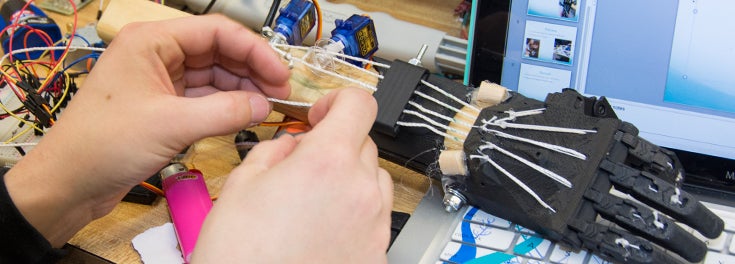 It’s a student’s worst nightmare: You’re late for class and you need to find a parking space—fast. URI engineering students have your problem solved, thanks to an intensive 12-day course they took during winter break called Engineering Entrepreneurship.
It’s a student’s worst nightmare: You’re late for class and you need to find a parking space—fast. URI engineering students have your problem solved, thanks to an intensive 12-day course they took during winter break called Engineering Entrepreneurship.
While their pals were off skiing, these seven civil, mechanical, and ocean engineering students were working 12-hour days in an engineering lab on campus creating things that were useful, creative—and downright amazing.
The instructors—MIT visiting scholar Rajesh Nair and URI ocean engineering professor James Miller—divided the students into three teams and assigned three projects. First, the students had to make a toy for a cat; then they built something to solve a real-world problem. Their final creation had to be good enough to launch a business.
Joe Saccoccia and Taylor Campbell came up with the “Rodent Runner,’’ a motorized mini cart that teases cats with a laser; an automated cat food dispenser made with PVC pipes; and the “Hurry App’’ to help URI motorists find a parking space. Sensors count the numbers of cars entering and exiting lots and provide alerts to harried drivers about available spaces.
Stand-alone mailboxes on curbs intrigued Adam Mazzantini and Sarah Visich. The problem: It’s difficult, if not impossible, to reach inside those mailboxes from a car window. The solution: A drawer that pulls in and out and is easily accessible from the driver’s seat.
It’s exciting to think about how to turn an idea into a business. Now I’ve got the tools for a startup.
“The class opened me up to a lot of new opportunities that I wouldn’t have experienced in a core curriculum class,’’ says Mazzantini. “Happy to give up hiking and biking for this.’’
Their final project was a robotic hand—born out of concern for Visich’s mother, who uses a wheelchair and has trouble reaching things. The “Handy-Can,’’ with an extendable arm, attaches to a wheelchair.
Kevin Lapierre, Kevin Stabinsky and Eilish Finneran created an app that measures temperature, humidity, sound and motion in science laboratories. The “Temp-Guard’’ system sends a text alert if something is amiss.
“I am truly getting a hands-on experience,’’ says Lapierre. “That’s important. I feel like when you’re trying to get a job in the real world that’s what they want.’’
And it’s exciting, he says, to think about how to turn an idea into a business. “Now I’ve got the tools for a startup. I also know how to make an app to turn my lights on at home. That’s cool.’’
Finneran was gleeful: “I love learning by doing. To me, that’s the best way to learn.’’
The 3-credit course is part of J Term, classed held during the winter break on campus and overseas to provide new educational opportunities for students.
Nair, a self-described “gadget designer’’ who has invented a few things himself, was impressed with the students’ work and says they have what it takes to be entrepreneurs: confidence. “The question is how do universities change their curriculum and teaching so they can help students become more productive—and employable—as entrepreneurs? We need to create this ecosystem at universities all over the world.’’
The students, it seems, would agree.
